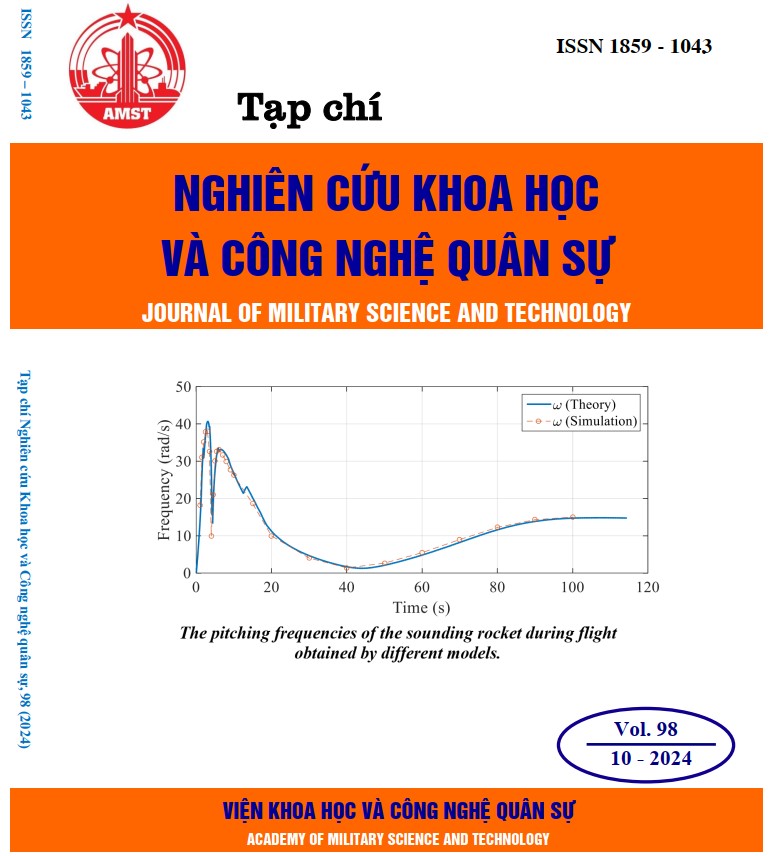Vật liệu carbon hoạt tính chế tạo từ nhựa thải PET hoạt hóa bằng H3PO4 ứng dụng xử lý phẩm màu RhB trong nước
442 lượt xemDOI:
https://doi.org/10.54939/1859-1043.j.mst.98.2024.94-100Từ khóa:
Rác thải nhựa; Nhựa PET; Carbon hoạt tính; Hấp phụ môi trường.Tóm tắt
Polyethylene terephthalate (PET) là loại nhựa tổng hợp được sử dụng rất phổ biến hiện nay, với nhu cầu sử dụng ngày càng cao. Hằng năm, một lượng lớn rác nhựa PET được thải trực tiếp ra môi trường. Vì vậy, việc tìm ra một phương pháp xử lý hiệu quả cho việc loại bỏ rác nhựa PET là vô cùng cần thiết. Trong nghiên cứu này, chúng tôi sử dụng rác nhựa PET để sản xuất cacbon hoạt tính bằng phương pháp hoạt hóa hóa học, sử dụng axit H3PO4 làm chất hoạt hoá. Khảo sát các yếu tố ảnh bao gồm tỷ lệ ngâm nhựa PET với H3PO4, nhiệt độ và thời hoạt hóa đến diện tích bề mặt của cacbon hoạt tính. Tính chất của cacbon hoạt tính được phân tích bằng kính hiển vi điện tử quét (SEM), nhiễu xạ tia X (XRD), phổ hồng ngoại Fourier (FTIR), và phân tích BET (Brunauer-Emmett-Teller). Kết quả cho thấy cacbon hoạt tính được tạo ra từ rác nhựa PET có diện tích bề mặt 892 m2/g, có khả năng hấp phụ Rhodamine B nồng độ 80 ppm theo mô hình hấp phụ đẳng nhiệt Langmuir nồng độ tối đa 45,45 mg/g.
Tài liệu tham khảo
[1]. Siddique, R., J. Khatib, and I.J.W.m. Kaur, “Use of recycled plastic in concrete: A review”. 28(10): p. 1835-1852, (2008). DOI: https://doi.org/10.1016/j.wasman.2007.09.011
[2]. Tournier, V., et al., “An engineered PET depolymerase to break down and recycle plastic bottles”. 580(7802): p. 216-219, (2020). DOI: https://doi.org/10.1038/s41586-020-2149-4
[3]. Geueke, B., K. Groh, and J.J.J.o.c.p. Muncke, “Food packaging in the circular economy: Overview of chemical safety aspects for commonly used materials”. 193: p. 491-505, (2018). DOI: https://doi.org/10.1016/j.jclepro.2018.05.005
[4]. Alam, O., et al., “Characteristics of plastic bags and their potential environmental hazards”. 132: p. 121-129, (2018). DOI: https://doi.org/10.1016/j.resconrec.2018.01.037
[5]. Ali, M.F., M.N.J.J.o.A. Siddiqui, and A. Pyrolysis, “Thermal and catalytic decomposition behavior of PVC mixed plastic waste with petroleum residue”. 74(1-2): p. 282-289, (2005). DOI: https://doi.org/10.1016/j.jaap.2004.12.010
[6]. Faraca, G. and T.J.W.M. Astrup, “Plastic waste from recycling centres: Characterisation and evaluation of plastic recyclability”. 95: p. 388-398, (2019). DOI: https://doi.org/10.1016/j.wasman.2019.06.038
[7]. Zhuo, C. and Y.A.J.J.o.A.P.S. Levendis, “Upcycling waste plastics into carbon nanomaterials: A review”. 131(4), (2014). DOI: https://doi.org/10.1002/app.39931
[8]. Qureshi, M.S., et al., “Pyrolysis of plastic waste: Opportunities and challenges”. 152: p. 104804, (2020). DOI: https://doi.org/10.1016/j.jaap.2020.104804
[9]. Miandad, R., et al., “Catalytic pyrolysis of plastic waste: A review”. 102: p. 822-838, (2016). DOI: https://doi.org/10.1016/j.psep.2016.06.022
[10]. Agenda, I. “The new plastics economy rethinking the future of plastics”. World Economic Forum. (2016).
[11]. Sharma, S., et al., “Synthesis of graphene crystals from solid waste plastic by chemical vapor deposition”. 72: p. 66-73, (2014). DOI: https://doi.org/10.1016/j.carbon.2014.01.051
[12]. Wang, Y., et al., “Application of carbon nanotube prepared from waste plastic to phase change materials: The potential for battery thermal management”. 154: p. 96-104, (2022). DOI: https://doi.org/10.1016/j.wasman.2022.10.003
[13]. Kumari, M., et al., “Transformation of solid plastic waste to activated carbon fibres for wastewater treatment”. 294: p. 133692, (2022). DOI: https://doi.org/10.1016/j.chemosphere.2022.133692
[14]. Cansado, I.P., et al. “Textural development of activated carbon prepared from recycled PET with different chemical activation agents”. Materials Science Forum. (2008). DOI: https://doi.org/10.4028/www.scientific.net/MSF.587-588.753
[15]. Zięzio, M., et al., “Preparation and characterization of activated carbons obtained from the waste materials impregnated with phosphoric acid (V)”. 10: p. 4703-4716, (2020). DOI: https://doi.org/10.1007/s13204-020-01419-6
[16]. Sureshkumar, A. and M.J.B.J.o.C.E. Susmita, “Optimization of preparation conditions for activated carbons from polyethylene terephthalate using response surface methodology”. 35: p. 1105-1116, (2018). DOI: https://doi.org/10.1590/0104-6632.20180353s20160724







